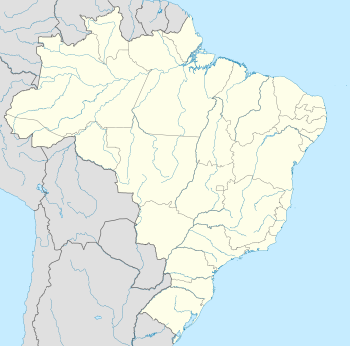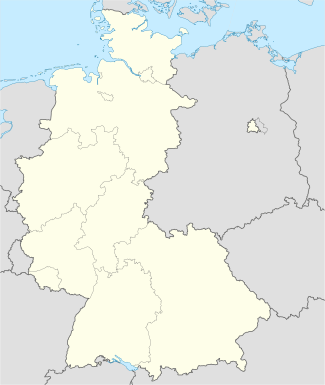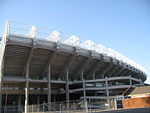List of FIFA World Cup stadiums
This article is regarding the stadiums used for FIFA World Cup.
Stadium Requirements[]
This list is incomplete; you can help by . (July 2018) |
FIFA have had strict stadium guideline requirements since at least 2001.[1] Stadiums must have a capacity of at least 40,000, stadiums hosting quarter-finals must have a minimum of 60,000 and those hosting the opening ceremony or final must have a capacity of at least 80,000.[2] In addition, stadiums must have a minimum number of television camera stands and media areas and also be free of advertising throughout the World Cup. This includes stadium names – for instance, during the 2006 World Cup, German stadiums such as Allianz Arena were renamed "FIFA World Cup Stadium – Munich" for licensing reasons.[3]
Statistics[]
This list is incomplete; you can help by . (July 2018) |
- Most matches hosted: Estadio Azteca (19 – 10 matches in 1970 and 9 matches in 1986)
- Most opening matches hosted: Estadio Azteca (2 – 1970 and 1986)
- Most finals hosted: Estadio Azteca (2 – 1970 and 1986), Maracanã Stadium (2 – 1950 and 2014)
- Highest attendance: Maracanã Stadium (173,850 - Final in 1950 )[4]
All-time stadiums[]
1930[]
All 1930 FIFA World Cup matches took place in Montevideo. Three stadiums were used: Estadio Centenario, Estadio Pocitos, and Estadio Parque Central. The Estadio Centenario was built both for the tournament and as a celebration of the centenary of Uruguayan independence. Designed by Juan Scasso,[5] it was the primary stadium for the tournament, referred to by Rimet as a "temple of football".[6] With a capacity of 90,000, it was the largest football stadium outside the British Isles.[7] The stadium hosted 10 of the 18 matches, including both semi-finals and the final. However, a rushed construction schedule and delays caused by the rainy season meant the Centenario was not ready for use until five days into the tournament.[8] Early matches were played at smaller stadiums usually used by Montevideo football clubs Nacional and Peñarol, the 20,000 capacity Parque Central and the Pocitos.
 Montevideo List of FIFA World Cup stadiums (Uruguay) |
Montevideo | ||
|---|---|---|---|
| Estadio Centenario | Estadio Gran Parque Central | Estadio Pocitos | |
| 34°53′40.38″S 56°9′10.08″W / 34.8945500°S 56.1528000°W | 34°54′4″S 56°9′32″W / 34.90111°S 56.15889°W | 34°54′18.378″S 56°9′22.42″W / 34.90510500°S 56.1562278°W | |
| Capacity: 90,000 | Capacity: 20,000 | Capacity: 1,000 | |
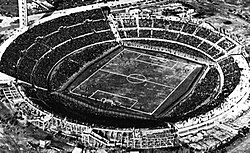
|
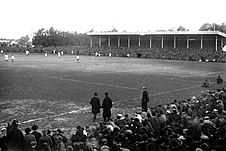
|

| |
1934[]
During the 1934 FIFA World Cup the number of supporters travelling from other countries was higher than at any previous football tournament, including 7,000 from the Netherlands and 10,000 each from Austria and Switzerland.[9]
 Bologna Florence Genoa Milan Naples Rome Trieste Turin |
Milan | Bologna | Rome | Florence |
|---|---|---|---|---|
| Stadio San Siro | Stadio Littoriale | Stadio Nazionale PNF | Stadio Giovanni Berta | |
| Capacity: 55,000 | Capacity: 50,100 | Capacity: 47,300 | Capacity: 47,290 | |

|

|

|

| |
| Naples | Genoa | Turin | Trieste | |
| Stadio Giorgio Ascarelli | Stadio Luigi Ferraris | Stadio Benito Mussolini | Stadio Littorio | |
| Capacity: 40,000 | Capacity: 36,703 | Capacity: 28,140 | Capacity: 8,000 | |

|

|

|

|
1938[]
Ten cities were planned to host the 1938 FIFA World Cup tournament; of these, all hosted matches except Lyon, which did not due to Austria's withdrawal.
 Antibes Bordeaux Le Havre Lille Lyon Marseille Colombes Paris Reims Strasbourg Toulouse List of FIFA World Cup stadiums (France) |
Colombes (suburbs of Paris) | Paris | Marseille | |
|---|---|---|---|---|
| Stade Olympique de Colombes | Parc des Princes | Stade Vélodrome | ||
| Capacity: 60,000 | Capacity: 48,712 | Capacity: 48,000 | ||

|

|

| ||
| Lyon | Toulouse | Bordeaux | Strasbourg | |
| Stade Gerland (only match cancelled) |
Stade du T.O.E.C. (in the old Parc des Sports), initially planned to the new stadium again in building (in the new Parc des Sports) |
Parc Lescure | Stade de la Meinau | |
| Capacity: 40,500 | Capacity: 15,000 | Capacity: 34,694 | Capacity: 30,000 | |
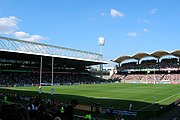
|

|

| ||
| Le Havre | Reims | Lille | Antibes | |
| Stade Municipal | Vélodrome Municipal | Stade Victor Boucquey | Stade du Fort Carré | |
| Capacity: 22,000 | Capacity: 21,684 | Capacity: 15,000 | Capacity: 7,000 | |

|

|

|

| |
1950[]
Six venues in six cities around Brazil hosted the 22 matches played for the 1950 FIFA World Cup. The Maracanã in the then-capital of Rio de Janeiro hosted eight matches, including all but one of the host's matches, including the Maracanazo match in the second round robin group that decided the winners of the tournament. The Pacaembu stadium in São Paulo hosted six matches; these two stadiums in São Paulo and Rio were the only venues that hosted the second round robin matches. The Estádio Sete de Setembro in Belo Horizonte hosted three matches, the Durival de Britto stadium in Curitiba and the Eucaliptos stadium in Porto Alegre each hosted two matches, and the Ilha do Retiro stadium in far-away Recife only hosted one match.
List of FIFA World Cup stadiums (Brazil) |
Rio de Janeiro | São Paulo | Belo Horizonte |
|---|---|---|---|
| Estádio do Maracanã | Estádio do Pacaembu | Estádio Sete de Setembro | |
| 22°54′43.8″S 43°13′48.59″W / 22.912167°S 43.2301639°W | 23°32′55.1″S 46°39′54.4″W / 23.548639°S 46.665111°W | 19°54′30″S 43°55′4″W / 19.90833°S 43.91778°W | |
| Capacity: 96,000 | Capacity: 60,000 | Capacity: 30,000 | |

|

|

| |
| Curitiba | Porto Alegre | Recife | |
| Estádio Durival de Britto | Estádio dos Eucaliptos | Estádio Ilha do Retiro | |
| 25°26′22″S 49°15′21″W / 25.43944°S 49.25583°W | 30°3′42″S 51°13′38″W / 30.06167°S 51.22722°W | 8°3′46.63″S 34°54′10.73″W / 8.0629528°S 34.9029806°W | |
| Capacity: 10,000 | Capacity: 20,000 | Capacity: 20,000 | |

|

|
1954[]
Six venues in six cities (1 venue in each city) hosted the 1954 FIFA World Cup tournament's 26 matches. The most used stadium was the St. Jakob stadium in Basel, which hosted 6 matches. The venues in Bern, Zurich and Lausanne each hosted 5 matches, the venue in Geneva hosted 4 matches and the venue in Lugano only hosted 1 match.
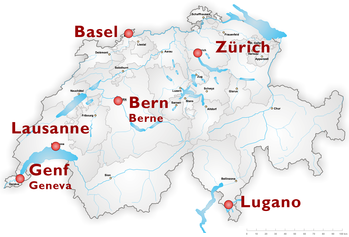 |
Bern | Basel | Lausanne |
|---|---|---|---|
| Wankdorf Stadium (upgraded) |
St. Jakob Stadium | Stade olympique de la Pontaise (upgraded) | |
| 46°57′46″N 7°27′54″E / 46.96278°N 7.46500°E | 47°32′29″N 7°37′12″E / 47.54139°N 7.62000°E | 46°32′00″N 006°37′27″E / 46.53333°N 6.62417°E | |
| Capacity: 64,600 | Capacity: 54,800 | Capacity: 50,300 | |

|

|

| |
| Geneva | Lugano | Zürich | |
| Charmilles Stadium | Cornaredo Stadium | Hardturm Stadium | |
| 46°12′33″N 6°07′06″E / 46.2091°N 6.1182°E | 46°01′25″N 8°57′42″E / 46.02361°N 8.96167°E | 47°23′35″N 8°30′17″E / 47.39306°N 8.50472°E | |
| Capacity: 35,997 | Capacity: 35,800 | Capacity: 34,800 | |

|

|

|
1958[]
A total of twelve cities throughout the central and southern parts of Sweden hosted the 1958 FIFA World Cup tournament. FIFA regulations required at least six stadiums to have a capacity of at least 20,000.[10] If Denmark had qualified, the organisers had planned to use the Idrætsparken in Copenhagen for Denmark's group matches.[10] The Idrætsparken was renovated in 1956 with this in mind, but Denmark lost out to England in qualification.[10] When doubts arose about whether funding would be forthcoming for rebuilding the Ullevi and Malmö Stadion, the organisers considered stadiums in Copenhagen and Oslo as contingency measures.[11]
The Rasunda Stadium was expanded from 38,000 for the World Cup by building end stands.[12] Organising committee chairman Holger Bergérus mortgaged his house to pay for this.[12] The new Malmö Stadion was built for the World Cup, replacing the 1896 Malmö Stadion at a new site[13] The Idrottsparken had 4,709 seats added for the World Cup. The Social Democratic municipal government refused to pay for this until the organisers threatened to select Folkungavallen in Linköping instead.[14] At the Rimnersvallen, a stand from the smaller Oddevallen stadium was moved to Rimnersvallen for the World Cup. The crowd at Brazil v. Austria was estimated at 21,000, with more looking in from the adjoining hillside.[12] The most used stadium was the Rasunda Stadium in Stockholm, which hosted 8 matches including the final, followed by the Ullevi Stadium in Gothenburg (the biggest stadium used during the tournament), which hosted 7 matches.
 Eskilstuna Gothenburg Halmstad Helsingborg Sandviken Stockholm Uddevalla |
Solna (Stockholm) | Gothenburg | Malmö | Helsingborg |
|---|---|---|---|---|
| Råsunda Stadium | Ullevi Stadium | Malmö Stadion | Olympia | |
| Capacity: 52,400 | Capacity: 53,500 | Capacity: 30,000 | Capacity: 27,000 | |

|

|

|

| |
| Eskilstuna | Norrköping | Sandviken | Uddevalla | |
| Tunavallen | Idrottsparken | Jernvallen | Rimnersvallen | |
| Capacity: 20,000 | Capacity: 20,000 | Capacity: 20,000 | Capacity: 17,778 | |
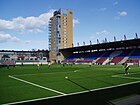
|

|

|

| |
| Borås | Halmstad | Örebro | Västerås | |
| Ryavallen | Örjans Vall | Eyravallen | Arosvallen | |
| Capacity: 15,000 | Capacity: 15,000 | Capacity: 13,000 | Capacity: 10,000 | |

|

|

|
1962[]
Originally, eight stadiums were selected to host the World Cup matches in eight different cities: Santiago, Viña del Mar, Rancagua, Arica, Talca, Concepción, Talcahuano and Valdivia.
The Valdivia earthquake, the most powerful earthquake ever recorded, occurred on 22 May 1960. With over 50,000 casualties and more than 2 million people affected, the earthquake forced the organising committee to completely modify the World Cup's calendar. Talca, Concepción, Talcahuano and Valdivia were severely damaged and discarded as venues. Antofagasta and Valparaíso declined to host any matches as their venues were not financially self-sustainable. Viña del Mar and Arica managed to rebuild their stadiums while Braden Copper Company, then an American company that controlled the El Teniente copper mine, allowed the use of its stadium in Rancagua. The most used stadium was the Estadio Nacional in Santiago, with 10 matches; the Estadio Sausalito in Viña del Mar hosted 8 matches, and the stadiums in Rancagua and far-away Arica (the only location that was not close to the other cities) both hosted 7 matches.
Being largely concerned with the build-up of the country after the 1960 earthquake, government support for the tournament was minimal.[15]
|
List of FIFA World Cup stadiums (Chile) |
Santiago | Viña del Mar |
|---|---|---|
| Estadio Nacional | Estadio Sausalito | |
| 33°27′52″S 70°36′38″W / 33.46444°S 70.61056°W | 33°00′51.83″S 71°32′6.84″W / 33.0143972°S 71.5352333°W | |
| Capacity: 66,660 | Capacity: 18,037 | |

|

| |
| Rancagua | Arica | |
| Estadio Braden Copper Co. | Estadio Carlos Dittborn | |
| 34°10′39.95″S 70°44′15.79″W / 34.1777639°S 70.7377194°W | 18°29′15.47″S 70°17′56.96″W / 18.4876306°S 70.2991556°W | |
| Capacity: 18,000 | Capacity: 17,786 | |

|

|
1966[]
Eight venues were used for this World Cup. The newest and biggest venue used was Wembley Stadium in west London, which was 43 years old in 1966. As was often the case in the World Cup, group matches were played in two venues in close proximity to each other. Group 1 matches (which included the hosts) were all played in London: five at Wembley, which was England's national stadium and was considered to be the most important football venue in the world; and one at White City Stadium in west London, which was used as a temporary replacement for nearby Wembley. The group stage match between Uruguay and France played at White City Stadium (originally built for the 1908 Summer Olympics) was scheduled for a Friday, the same day as regularly scheduled greyhound racing at Wembley. Because Wembley's owner refused to cancel this, the game had to be moved to the alternative venue in London. Group 2's matches were played at Hillsborough Stadium in Sheffield and Villa Park in Birmingham; Group 3's matches were played at Old Trafford in Manchester and Goodison Park in Liverpool; and Group 4's matches were played at Ayresome Park in Middlesbrough and Roker Park in Sunderland.
The most used venue was Wembley, which was used for nine matches, including all six featuring England, the final and the third-place match. Goodison Park was used for five matches, Roker Park and Hillsborough both hosted four, while Old Trafford, Villa Park and Ayresome Park each hosted three matches and did not host any knockout round matches.
 London Manchester Liverpool Sunderland Middlesbrough Birmingham Sheffield |
London | Manchester | Birmingham | |
|---|---|---|---|---|
| Wembley Stadium | White City Stadium | Old Trafford | Villa Park | |
| Capacity: 98,600 | Capacity: 76,567 | Capacity: 58,000 | Capacity: 52,000 | |
 |
 |

| ||
| Sheffield | Sunderland | Middlesbrough | Liverpool | |
| Hillsborough Stadium | Roker Park | Ayresome Park | Goodison Park | |
| Capacity: 42,730 | Capacity: 40,310 | Capacity: 40,000 | Capacity: 50,151 | |
 |
 |
 |

| |
1970[]
Five stadiums in five cities were selected to host the World Cup matches. Alternative venues in Hidalgo state and the port city of Veracruz were also considered.[16] Each group was based solely in one city with exception of Group 2, which was staged in both Puebla and Toluca. Aside from the Estadio Luis Dosal, all the stadia had only been constructed during the 1960s, as Mexico prepared to host both the World Cup and the 1968 Summer Olympics.[17]
The altitude of the venues varied and the importance of acclimatisation was strongly considered by all the participating teams. As a result, in contrast to the previous tournament staged in England, most teams arrived in the region well in advance of their opening fixtures to prepare for this factor.[18][19] Some teams had already experienced the local conditions when competing in the football competition at 1968 Summer Olympics.[20] At an elevation in excess of 2,660 metres (8,730 ft) above sea level, Toluca was the highest of the venues; Guadalajara was the lowest at 1,500 m (4,920 ft).
Of the five stadia used for the 32 matches played, the largest and most used venue was the Azteca Stadium in Mexico City; which hosted ten total matches including the final and third place matches, and all of Group 1's matches (which included all of host Mexico's matches). The Jalisco Stadium in Guadalajara hosted eight matches including all of Group 3's matches and a semi-final. The Nou Camp Stadium in Leon hosted seven matches, which consisted of all of Group 4's matches and a quarter-final match. The Luis Dosal stadium in Toluca hosted four matches, and Cuauhtémoc stadium in Puebla hosted three matches and was the only stadium of the five used for this tournament not to host any knockout rounds.
|
List of FIFA World Cup stadiums (Mexico) |
Mexico City | Guadalajara | |
|---|---|---|---|
| Estadio Azteca | Estadio Jalisco | ||
| Capacity: 107,247 | Capacity: 71,100 | ||

|

| ||
| Puebla | Toluca | León | |
| Estadio Cuauhtémoc | Estadio Luis Dosal | Estadio Nou Camp | |
| Capacity: 35,563 | Capacity: 26,900 | Capacity: 23,609 | |

|

|

| |
1974[]
| Munich | West Berlin | Stuttgart | Gelsenkirchen | Düsseldorf | |
|---|---|---|---|---|---|
| Olympiastadion | Olympiastadion | Neckarstadion | Parkstadion | Rheinstadion | |
| Capacity: 77,573 | Capacity: 86,000 | Capacity: 72,200 | Capacity: 72,000 | Capacity: 70,100 | |

|

|

|

|

| |
| Frankfurt | Hamburg | Hanover | Dortmund | ||
| Waldstadion | Volksparkstadion | Niedersachsenstadion | Westfalenstadion | ||
| Capacity: 62,200 | Capacity: 61,300 | Capacity: 60,400 | Capacity: 53,600 | ||

|

|

|

| ||
1978[]
Of the 6 venues used, the Argentine national stadium, the Estadio Monumental in Buenos Aires was the largest and most used venue, hosting 9 total matches, including the final match. The Carreras Stadium in Córdoba hosted 8 matches, the stadiums in Mendoza, Rosario and Mar del Plata each hosted 6 matches and the José Amalfitani Stadium in Buenos Aires hosted 3 matches. The Minella stadium in Mar del Plata was heavily criticized due to its terrible pitch, which was deemed "nearly unplayable"; whereas the Amalfitani stadium in Buenos Aires, the least used stadium for this tournament, was praised for its very good pitch.[citation needed]
Brazil was forced by tournament organizers to play all three of its first group matches in Mar del Plata.
| Buenos Aires | Córdoba | ||
|---|---|---|---|
| Estadio Monumental | José Amalfitani Stadium | Estadio Córdoba | |
| Capacity: 74,624 | Capacity: 49,318 | Capacity: 46,986 | |

|

|

| |
| Mar del Plata | Rosario | Mendoza | |
| Estadio José María Minella | Estadio Gigante de Arroyito | Estadio Ciudad de Mendoza | |
| Capacity: 43,542 | Capacity: 41,654 | Capacity: 34,954 | |

|

|

| |
1982[]
17 stadiums in 14 cities hosted the tournament, a record until the 2002 tournament which was hosted by 20 stadiums.[21] The most used stadium was FC Barcelona's Camp Nou stadium which hosted 5 matches including a semi-final match; it was the largest stadium used for this tournament. In addition to Barcelona's Sarria Stadium hosting 3 total matches, Barcelona was the Spanish city with the most matches in Espana '82 with 8; the Spanish capital of Madrid followed with 7.
This particular World Cup was organised in such a way where all of the matches of each of the six groups of four were assigned stadiums in cities close in proximity to each other; reducing the stress of travel on the players and fans. For example: Group 1 only played in Vigo and A Coruña, Group 2 only played in Gijón and Oviedo, Group 3 only played in Elche and Alicante (except for the first match, which was the opening match of the tournament, which was played at the Camp Nou), Group 4 played only in Bilbao and Valladolid (England played all their first round group matches in Bilbao), Group 5 (which included hosts Spain) was played exclusively in Valencia and Zaragoza, and Group 6 played exclusively in Seville and Málaga (of the 3 1st round matches in Seville, the first match between Brazil and the USSR was played in the Ramón Sánchez Pizjuán Stadium, and the other two were played in the Villamarin Stadium).
When the tournament went into the round-robin second round matches, all the aforementioned cities excluding Barcelona, Alicante and Seville did not host any more matches in Espana '82. Both the Santiago Bernabéu and Vicente Calderón stadiums in Madrid and the Sarria Stadium in Barcelona were used for the first time for this tournament for the second round matches. Madrid and Barcelona hosted the four second round group matches; Barcelona hosted Groups A and C (Camp Nou hosted all 3 of Group A's matches, and Sarria did the same with Group C's matches) and Madrid hosted Groups B and D (Real Madrid's Bernabeu Stadium hosted all 3 of Group B's matches, and Atlético Madrid's Calderon Stadium did the same with the Group D matches)
The two semi final matches were held at Camp Nou and the Pizjuan Stadium in Seville, the third largest stadium used for the tournament (one of only 2 Espana '82 matches it hosted), the third place match was held in Alicante and the final was held at the Bernabeu, the second largest stadium used for this tournament.[22]
Spain's hot summer climate was avoided by playing most matches in the late afternoon or at night; for instance Seville- which is one of the hottest cities in Europe, with June and July average temperatures going past the 90s Fahrenheit (32 Celsius)- could only play its matches at 21:00. During the group stages, all the southern coastal cities with their hot summer weather saw all their matches start at 21:00 local time; and the northern cities with their cooler weather had their matches start at 17:15 local time.
| Madrid | Barcelona | Elche | ||||
|---|---|---|---|---|---|---|
| Santiago Bernabéu | Vicente Calderón | Camp Nou | Sarrià | Martínez Valero | ||
| Capacity: 90,800 | Capacity: 65,695 | Capacity: 97,679 | Capacity: 40,400 | Capacity: 53,290 | ||

|

|

|

|
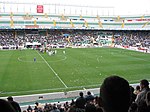
| ||
| Sevilla | Valencia | Bilbao | Gijón | |||
| Ramón Sánchez Pizjuán | Benito Villamarín | Luis Casanova | San Mamés | El Molinón | ||
| Capacity: 68,110 | Capacity: 50,253 | Capacity: 47,542 | Capacity: 46,223 | Capacity: 45,153 | ||

|

|
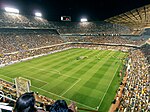
|

|

| ||
| Zaragoza | Málaga | A Coruña | Vigo | Valladolid | Alicante | Oviedo |
| La Romareda | La Rosaleda | Riazor | Balaídos | José Zorrilla | José Rico Pérez | Carlos Tartiere |
| Capacity: 41,806 | Capacity: 34,411 | Capacity: 34,190 | Capacity: 33,000 | Capacity: 29,990 | Capacity: 28,421 | Capacity: 23,500 |

|

|
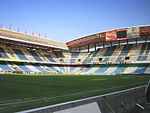
|

|
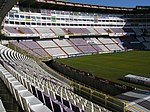
|

|
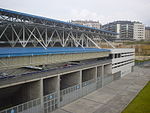
|
1986[]
Eleven cities hosted the tournament. The Estadio Azteca in Mexico City, the largest stadium used for the tournament, hosted 9 matches (including the final), more than any other stadium used. Mexico City hosted 13 total matches; the Olimpico Universitario Stadium hosted 4 matches (if the Mexico City suburban town Nezahualcoyotl's matches are included, this brings the total up to 16 matches). The Estadio Jalisco in Guadalajara hosted 7 matches, and the Estiado Cuauhtémoc in Puebla hosted 5 matches.
The hot and rainy summer weather in Mexico varied from desert locations like Monterrey to tropical locations such as Guadalajara; but perhaps the greatest hardship the players had to contend with was the high altitude of the Mexican locations. With the exception of Monterrey (still 2,000 feet above sea level), all of the stadia were located in cities that varied anywhere from Guadalajara being 5,138 feet (1,566 meters) above sea level to Toluca being 8,730 feet (2,661 m) above sea level- making conditions very difficult for the players running around in these stadia. Mexico City, the location of the final match and the location where the most matches were played was 7,380 feet (2,250 m) above sea level.
|
1. Mexico City, 2. Guadalajara, 3. Puebla, 4. San Nicolás, |
Mexico City | Guadalajara | Puebla | ||
|---|---|---|---|---|---|
| Estadio Azteca | Estadio Olímpico Universitario | Estadio Jalisco | Estadio Cuauhtémoc | ||
| Capacity: 110,574 | Capacity: 72,212 | Capacity: 66,193 | Capacity: 46,416 | ||

|

|

|
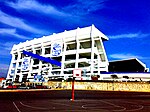
| ||
| San Nicolás de los Garza | Querétaro | Nezahualcoyotl | Monterrey | ||
| Estadio Universitario | Estadio La Corregidora | Estadio Neza 86 | Estadio Tecnológico | ||
| Capacity: 43,780 | Capacity: 38,576 | Capacity: 34,536 | Capacity: 33,805 | ||

|

|

|

| ||
| Toluca | Irapuato | León | Zapopan | ||
| Estadio Nemesio Díez | Estadio Sergio León Chávez | Estadio Nou Camp | Estadio Tres de Marzo | ||
| Capacity: 32,612 | Capacity: 31,336 | Capacity: 30,531 | Capacity: 30,015 | ||

|

|
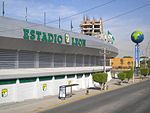
|

| ||
All of these venues except Monterrey were located in central Mexico, as this tournament was organised with the then-standard way of keeping teams playing in locations in close proximity to each other. Group A only played at the Olimpico and in Puebla (except for the Bulgaria-Italy opening tournament match, which was played in the Azteca), Group B only played at the Azteca and in Toluca (hosts Mexico were drawn in this group; they played all their group stage matches at the Azteca), Group C played in León and Irapuato, Group D only played in Guadalajara (including the Guadalajara area town of Zapopan; the last match of this group was played in Monterrey), Group E exclusively played in Querétaro and Nezahualcóyotl, and Group F played in the northern city of Monterrey (including the Monterrey area town of San Nicolas de los Garza; the last match of this group was played in Guadalajara). All of the venues listed hosted knockout round matches except the ones in Nezahualcoyotl, Irapuato, Zapopan, Toluca and the Estadio Tecnológico in Monterrey.
1990[]
Twelve stadiums were selected to host the World Cup matches in twelve different cities. The Stadio San Nicola in Bari and Turin's Stadio delle Alpi were completely new venues opened for the World Cup.
The remaining ten venues all underwent extensive programmes of improvements in preparation for the tournament, forcing many of the club tenants of the stadia to move to temporary homes. Additional seating and roofs were added to most stadia, with further redevelopments seeing running tracks removed and new pitches laid. Due to structural constraints, several of the existing stadia had to be virtually rebuilt to implement the changes required.
Like Espana '82, the group stage of this tournament was organized in such a way where specific groups only played in two cities close in proximity to each other. Group A only played in Rome and Florence (Hosts Italy played all their competitive matches in Rome, except for their semi-final and third place matches, which were played in Naples and Bari, respectively), Group B played their matches in Naples and Bari (except for Argentina vs. Cameroon, which was the opening match of the tournament, played in Milan), Group C played their matches in Turin and Genoa, Group D played all their matches in Milan and Bologna, Group E played only in Udine and Verona, and Group F played on the island cities of Cagliari and Palermo. The cities that hosted the most World Cup matches were the two biggest cities in Italy: Rome and Milan, each hosting six matches, and Bari, Naples and Turin each hosted five matches. Cagliari, Udine, and Palermo were the only cities of the 12 selected that did not host any knockout round matches. All matches, typical of a World Cup in Europe were played in the late afternoon or the evening to avoid the intense heat of an Italian summer.
The England national team, at the British government's request, were forced to play all their matches at Stadio Sant'Elia in Cagliari on the island of Sardinia. Hooliganism, rife in English football in the 1980s, had followed the national team while they played friendlies on the European continent – the distrust of English fans was so high that the English FA's reputation and even diplomatic relations between the U.K. and Italy were seen to be at risk if England played any group stage matches on the Italian mainland. Thanks largely to British Sports Minister Colin Moynihan's negative remarks about English fans weeks before the match, security around Cagliari during England's three matches there was extremely heavy – in addition to 7,000 local police and Carabineri, highly trained Italian military special forces were also there patrolling the premises. The Italian authorities' heavy presence proved to be justified as there were several riots during the time England were playing their matches in Cagliari, leading to a number of injuries, arrests and even deportations.[23][24]
Most of the construction cost in excess of their original estimates and total costs ended up being over £550 million (approximately $935 million). Rome's Stadio Olimpico which would host the final was the most expensive project overall, while Udine's Stadio Friuli, the newest of the existing stadia (opened 14 years prior), cost the least to redevelop.
1994[]
The games were played in nine cities across the country. All stadiums had a capacity of at least 53,000, and their usual tenants were professional or college American football teams. The venue used most was the Rose Bowl in Pasadena, with eight games, among them one round of 16 match, a semi-final, the third-place game, and the final. The least used was the Pontiac Silverdome near Detroit, the first indoor stadium used in a World Cup, with four group stage games. The Pontiac Silverdome was also the only venue of the 9 used that did not host any knockout round matches.
Because of the large area of the continental United States, the match locations were often far apart. Some teams in Groups A and B had to travel from Los Angeles or San Francisco all the way to Detroit and back again, covering 2,300 mi (3,680 km) and three time zones one way. The teams in Groups C and D only played in Foxborough (Boston), Chicago and Dallas – a trip from Boston to Dallas is 2,000 miles (3,200 km), but only covers one time zone; Chicago is in the same time zone as Dallas but is still 1,000 miles (1,600 km) away from both Dallas and Boston. The teams in Groups E and F's travel was a bit easier – they played exclusively in East Rutherford (New York City), Washington and Orlando. A few teams such as Cameroon and Italy did not have to travel great distances to cities to play matches.
The variety of climate in different cities all over the United States made playing conditions challenging; aside from the oceanic coolness of Boston (Foxborough), the Mediterranean climate of San Francisco (Stanford) and occasionally the coolness of Chicago, most matches were played in very hot and/or humid conditions. Although playing in the sometimes triple-digit dry heat and smoggy conditions of Los Angeles (Pasadena) and the intense mixture of heat and humidity of Washington and New York City (East Rutherford) proved to be difficult, the cities with the most oppressive conditions were the southern cities of Orlando and Dallas because of the combination of triple-digit heat and extreme humidity.[27] The Floridian tropical climate of Orlando meant all matches there were played in temperatures of 95 °F (35 °C) or above with humidity at 70% or more (the temperature there during the group stage match between Mexico and Ireland was 105 °F (41 °C)) thanks to the mid-day start times.[28] Dallas was not much different: in the semi-arid heat of a Texas summer, temperatures exceeded 100 °F (38 °C) during mid-day, when matches there were staged in the open-type Cotton Bowl meant that conditions were just as oppressive there as they were in Orlando.[29] Detroit also proved to be difficult: the Pontiac Silverdome did not have a working cooling system and because it was an interior dome-shaped stadium, the air could not escape through circulation, so temperatures inside the stadium would climb past 90 °F (32 °C) with 40% humidity. United States midfielder Thomas Dooley described the Silverdome as "the worst place I have ever played at".[30]
 Pasadena Pontiac Stanford East Rutherford Orlando Chicago Dallas Foxborough Washington, D.C. List of FIFA World Cup stadiums (the United States) |
Pasadena, California (Los Angeles area) |
Stanford, California (San Francisco Bay Area) |
Pontiac, Michigan (Detroit area) |
|---|---|---|---|
| Rose Bowl | Stanford Stadium | Pontiac Silverdome | |
| Capacity: 91,794 | Capacity: 80,906 | Capacity: 77,557 | |

|

|

| |
| East Rutherford, New Jersey (New York City area) |
Dallas | Chicago, Illinois | |
| Giants Stadium | Cotton Bowl | Soldier Field | |
| Capacity: 75,338 | Capacity: 63,998 | Capacity: 63,117 | |

|

|

| |
| Orlando, Florida | Foxborough, Massachusetts (Boston area) |
Washington, D.C. | |
| Citrus Bowl | Foxboro Stadium | Robert F. Kennedy Memorial Stadium | |
| Capacity: 61,219 | Capacity: 53,644 | Capacity: 53,142 | |

|
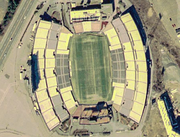
|

|
1998[]
France's bid to host the World Cup centered on a national stadium with 80,000 seats and nine other stadiums located across the country.[31] When the finals were originally awarded in July 1992, none of the regional club grounds were of a capacity meeting FIFA's requirements – namely being able to safely seat 40,000.[31] The proposed national stadium, colloquially referred to as the 'Grand stade' met with controversy at every stage of planning; the stadium's location was determined by politics, finance and national symbolism.[32] As Mayor of Paris, Jacques Chirac successfully negotiated a deal with Prime Minister Édouard Balladur to bring the Stade de France – as it was named now, to the commune of Saint-Denis just north of the capital city.[32] Construction on the stadium started in December 1995 and was completed after 26 months of work in November 1997 at a cost of ₣2.67 billion.[33]
The choice of stadium locations was drafted from an original list of 14 cities.[34] FIFA and CFO monitored the progress and quality of preparations, culminating in the former providing final checks of the grounds weeks before the tournament commenced. Montpellier was the surprise inclusion from the final list of cities because of its low urban hierarchy in comparison to Strasbourg, who boasted a better hierarchy and success from its local football team, having been taken over by a consortium. Montpellier however was considered ambitious by the selecting panel to host World Cup matches. The local city and regional authories in particular had invested heavily into football the previous two decades and were able to measure economic effects, in terms of jobs as early as in 1997.[35] Some of the venues used for this tournament were also used for the previous World Cup in France in 1938. The Stade Vélodrome in Marseille, the Parc Lescure in Bordeaux and the Parc des Princes in Paris received the honour of hosting World Cup matches once again in 1998 as they had all done in 1938.
10 stadiums in total were used for the finals; in addition to nine matches being played at the Stade de France (the most used stadium in the tournament), a further six matches took place in Paris Saint-Germain's Parc des Princes, bringing Paris's total matches hosted to 15. France played four of their seven matches in the national stadium; they also played in the country's second and third largest cities, Marseille (hosting 7 total matches) and Lyon (hosting 6 total matches), as well as a Round of 16 knockout match in the northern city of Lens (also hosting 6 total matches). Nantes, Toulouse, Bordeaux, Montpellier and Saint-Étienne also hosted 6 matches in total; all of the stadiums used also hosted knockout round matches.
| Saint-Denis | Marseille | Paris | Lyon | ||
|---|---|---|---|---|---|
| Stade de France | Stade Vélodrome | Parc des Princes | Stade de Gerland | ||
| 48°55′28″N 2°21′36″E / 48.92444°N 2.36000°E | 43°16′11″N 5°23′45″E / 43.26972°N 5.39583°E | 48°50′29″N 2°15′11″E / 48.84139°N 2.25306°E | 45°43′26″N 4°49′56″E / 45.72389°N 4.83222°E | ||
| Capacity: 80,000 | Capacity: 60,000 | Capacity: 48,875 | Capacity: 44,000 | ||

|

|

|

| ||
| Lens | Nantes | Toulouse | Saint-Étienne | Bordeaux | Montpellier |
| Stade Félix-Bollaert | Stade de la Beaujoire | Stadium de Toulouse | Stade Geoffroy-Guichard | Parc Lescure | Stade de la Mosson |
| 50°25′58.26″N 2°48′53.47″E / 50.4328500°N 2.8148528°E | 47°15′20.27″N 1°31′31.35″W / 47.2556306°N 1.5253750°W | 43°34′59.93″N 1°26′2.57″E / 43.5833139°N 1.4340472°E | 45°27′38.76″N 4°23′24.42″E / 45.4607667°N 4.3901167°E | 44°49′45″N 0°35′52″W / 44.82917°N 0.59778°W | 43°37′19.85″N 3°48′43.28″E / 43.6221806°N 3.8120222°E |
| Capacity: 41,300 | Capacity: 39,500 | Capacity: 37,000 | Capacity: 36,000 | Capacity: 35,200 | Capacity: 34,000 |
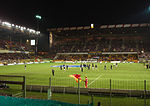
|

|

|
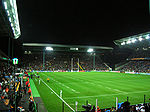
|

|

|
2002[]
South Korea and Japan each provided 10 venues, the vast majority of them newly built for the tournament. Groups A-D played all their matches in South Korea, and Groups E-H played all their matches in Japan.[36] The stadiums in Daegu, Suwon, Yokohama and Saitama all hosted 4 matches each, while the other 16 stadiums hosted 3 matches each. Notably, no matches were played in Tokyo, making it the first capital of a host country not to have a World Cup venue.
| South Korea | |||||
|---|---|---|---|---|---|
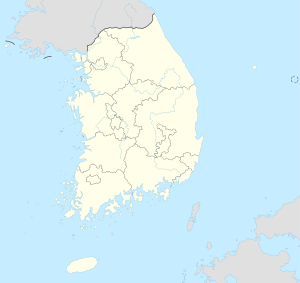 Busan Daegu Daejeon Gwangju Incheon Jeonju Seogwipo Seoul Suwon Ulsan Japan |
Daegu | Seoul | Busan | Incheon | Ulsan |
| Daegu World Cup Stadium Capacity: 68,014[37] Group/Knock-out/third place |
Seoul World Cup Stadium Capacity: 63,961[38] Group/Knock-out |
Busan Asiad Stadium Capacity: 55,982[39] Group |
Incheon Munhak Stadium Capacity: 52,179[40] Group |
Ulsan Munsu Football Stadium Capacity: 43,550[41] Group/Knock-out | |

|

|

|

| ||
| Suwon | Gwangju | Jeonju | Seogwipo | Daejeon | |
| Suwon World Cup Stadium Capacity: 43,188[42] Group/Knock-out |
Gwangju World Cup Stadium Capacity: 42,880[43] Group/Knock-out |
Jeonju World Cup Stadium Capacity: 42,391[44] Group/Knock-out |
Jeju World Cup Stadium Capacity: 42,256[45] Group/Knock-out |
Daejeon World Cup Stadium Capacity: 40,407[46] Group/Knock-out | |

|

|

|

|

| |
| Japan | |||||
|
|
Yokohama | Saitama | Fukuroi | Osaka | Sendai |
| International Stadium Yokohama Capacity: 72,327[47] Group/Knock-out/Final |
Saitama Stadium 2002 Capacity: 63,000[48] Group/Knock-out |
Shizuoka "Ecopa" Stadium Capacity: 50,600[49] Group/Knock-out |
Nagai Stadium Capacity: 50,000[50] Group/Knock-out |
Miyagi Stadium Capacity: 49,000[51] Group/Knock-out | |

|

|

|
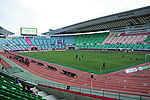
|
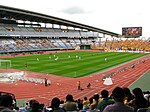
| |
| Ōita | Niigata | Kashima | Kobe | Sapporo | |
| Ōita Stadium Capacity: 43,000[52] Group/Knock-out |
Niigata Stadium Capacity: 42,300[53] Group/Knock-out |
Kashima Soccer Stadium Capacity: 42,000[54] Group |
Kobe Wing Stadium Capacity: 42,000[55] Group/Knock-out |
Sapporo Dome Capacity: 42,000[56] Group | |

|
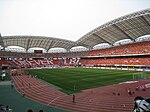
|

|
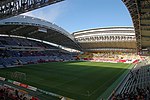
|

| |
2006[]
In 2006, Germany had a plethora of football stadia that satisfied FIFA's minimum capacity of 40,000 seats for World Cup matches. The still-standing Olympiastadion in Munich (69,250) was not used for the tournament, even though FIFA's regulations allow one city to use two stadia. Düsseldorf's LTU Arena (51,500), Bremen's Weserstadion (43,000) and Mönchengladbach's Borussia-Park (46,249) were also not used.
Twelve stadia were selected to host the World Cup matches. During the tournament, many of them were known by different names, as FIFA prohibits sponsorship of stadia unless the stadium sponsors are also official FIFA sponsors.[57] For example, the Allianz Arena in Munich was known during the competition as FIFA World Cup Stadium, Munich (German: FIFA WM-Stadion München), and even the letters of the company Allianz were removed or covered.[57] Some of the stadia also had a lower capacity for the World Cup, as FIFA regulations ban standing room; nonetheless, this was accommodated as several stadia had a UEFA five-star ranking. The stadia in Berlin, Munich, Dortmund and Stuttgart hosted six matches each, while the other eight stadia hosted five matches each.
 Berlin Dortmund Munich Stuttgart Gelsenkirchen Hamburg Frankfurt Cologne Hanover Leipzig Kaiserslautern Nuremberg List of FIFA World Cup stadiums (Germany) |
Berlin | Dortmund | Munich | Stuttgart | Gelsenkirchen | |
|---|---|---|---|---|---|---|
| Olympiastadion | Westfalenstadion | Allianz Arena | Gottlieb-Daimler-Stadion | Arena AufSchalke | ||
| FIFA World Cup Stadium, Dortmund | FIFA World Cup Stadium, Munich | FIFA World Cup Stadium, Gelsenkirchen | ||||
| 52°30′53″N 13°14′22″E / 52.51472°N 13.23944°E | 51°29′33.25″N 7°27′6.63″E / 51.4925694°N 7.4518417°E | 48°13′7.59″N 11°37′29.11″E / 48.2187750°N 11.6247528°E | 48°47′32.17″N 9°13′55.31″E / 48.7922694°N 9.2320306°E | 51°33′16.21″N 7°4′3.32″E / 51.5545028°N 7.0675889°E | ||
| Capacity: 72,000[58] | Capacity: 65,000[59] | Capacity: 66,000[60] | Capacity: 52,000[61] | Capacity: 52,000[62] | ||

|

|

|

|

| ||
| Hamburg | Frankfurt | Cologne | Hanover | Leipzig | Kaiserslautern | Nuremberg |
| Volksparkstadion | Commerzbank-Arena | RheinEnergieStadion | Niedersachsenstadion | Zentralstadion | Fritz-Walter-Stadion | Max-Morlock-Stadion |
| FIFA World Cup Stadium, Hamburg | FIFA World Cup Stadium, Frankfurt | FIFA World Cup Stadium, Cologne | FIFA World Cup Stadium, Hanover | Frankenstadion | ||
| 53°35′13.77″N 9°53′55.02″E / 53.5871583°N 9.8986167°E | 50°4′6.86″N 8°38′43.65″E / 50.0685722°N 8.6454583°E | 50°56′0.59″N 6°52′29.99″E / 50.9334972°N 6.8749972°E | 52°21′36.24″N 9°43′52.31″E / 52.3600667°N 9.7311972°E | 51°20′44.86″N 12°20′53.59″E / 51.3457944°N 12.3482194°E | 49°26′4.96″N 7°46′35.24″E / 49.4347111°N 7.7764556°E | 49°25′34″N 11°7′33″E / 49.42611°N 11.12583°E |
| Capacity: 50,000[63] | Capacity: 48,000[64] | Capacity: 45,000[65] | Capacity: 43,000[66] | Capacity: 43,000[67] | Capacity: 46,000[68] | Capacity: 41,000[69] |

|

|

|

|

|

|

|
2010[]
In 2005, the organisers released a provisional list of 13 venues to be used for the World Cup: Bloemfontein, Cape Town, Durban, Johannesburg (two venues), Kimberley, Klerksdorp, Nelspruit, Orkney, Polokwane, Port Elizabeth, Pretoria, and Rustenburg. This was narrowed down to the ten venues[70] that were officially announced by FIFA on 17 March 2006.
The altitude of several venues affected the motion of the ball[71] and player performance,[72][73] although FIFA's medical chief downplayed this consideration.[74] Six of the ten venues were over 1200m above sea level, with the two Johannesburg venues – the FNB Stadium (also known as Soccer City) and Ellis Park Stadium – the highest at approximately 1750m.[75][76]
The FNB Stadium, the Cape Town Stadium and the Nelson Mandela Bay Stadium in Port Elizabeth were the most-used venues, each hosting eight matches. Ellis Park Stadium and the Moses Mabhida Stadium in Durban hosted seven matches each, while the Loftus Versfeld Stadium in Pretoria, the Free State Stadium in Bloemfontein and the Royal Bafokeng Stadium in Rustenburg hosted six matches each. The Peter Mokaba Stadium in Polokwane and the Mbombela Stadium in Nelspruit hosted four matches each, but did not host any knockout-stage matches.
2014[]
12 venues (seven new and five renovated) in twelve cities were selected for the tournament. The venues covered all the main regions of Brazil and created more evenly distributed hosting than the 1950 finals in Brazil.[78] Consequently, the tournament required long-distance travel for teams.[79] During the World Cup, Brazilian cities were also home to the participating teams at 32 separate base camps,[80] as well as staging official fan fests where supporters could view the games.[81]
The most-used stadiums were the Maracana and Brasília, which hosted 7 matches each. São Paulo, Fortaleza, Belo Horizonte and Salvador hosted 6 matches each, Porto Alegre and Recife hosted 5 matches each, and Cuiaba, Manaus, Natal and Curitiba hosted 4 matches each and being the 4 smallest stadiums used, the 4 aforementioned cities did not host any knockout rounds.[82]
| Rio de Janeiro | Brasília | São Paulo | Fortaleza | Belo Horizonte | ||
|---|---|---|---|---|---|---|
| Estádio do Maracanã | Estádio Nacional | Arena de São Paulo | Estádio Castelão | Estádio Mineirão | ||
| Capacity: 74,738[82] | Capacity: 69,432[82] | Capacity: 63,321[82] | Capacity: 60,348[82] | Capacity: 58,259[82] | ||
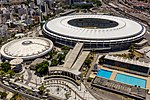
|

|

|

|

| ||
| Salvador | Porto Alegre | Recife [nb 1] | Cuiabá | Manaus | Natal | Curitiba |
| Arena Fonte Nova | Estádio Beira-Rio | Arena Pernambuco | Arena Pantanal | Arena da Amazônia | Arena das Dunas | Arena da Baixada |
| Capacity: 51,708[82] | Capacity: 43,394[82] | Capacity: 42,583[82] | Capacity: 41,112[82] | Capacity: 40,549[82] | Capacity: 39,971[82] | Capacity: 39,631[82] |

|

|

|

|

|

|

|
- ^ The Itaipava Arena Pernambuco is located in São Lourenço da Mata, Recife metropolitan area.
2018[]
A total of twelve stadiums in eleven Russian cities have been built and renovated for the FIFA World Cup.[83]
- Kaliningrad: Kaliningrad Stadium. The first piles were driven into the ground in September 2015. On 11 April 2018 the new stadium hosted its first match.
- Kazan: Kazan Arena. The stadium was built for the 2013 Summer Universiade. It has since hosted the 2015 World Aquatics Championship and the 2017 FIFA Confederations Cup. The stadium serves as a home arena to FC Rubin Kazan.
- Moscow: Luzhniki Stadium. The largest stadium in the country was closed for renovation in 2013. The stadium was commissioned in November 2017.
- Moscow: Spartak Stadium. The stadium is a home arena to its namesake FC Spartak Moscow. In accordance with the FIFA requirements, during the 2018 World Cup it is called Spartak Stadium instead of its usual name Otkritie Arena. The stadium hosted its first match on 5 September 2014.
- Nizhny Novgorod: Nizhny Novgorod Stadium. The construction of the Nizhny Novgorod Stadium commenced in 2015. The project was completed in December 2017.[84]
- Rostov-on-Don: Rostov Arena. The stadium is located on the left bank of the Don River. The stadium construction was completed on 22 December 2017.
- Saint Petersburg: Saint Petersburg Stadium. The construction of the stadium commenced in 2007. The project was officially completed on 29 December 2016.[85] The stadium has hosted games of the 2017 FIFA Confederations Cup and will serve as a venue for UEFA Euro 2020.
- Samara: Samara Arena. The construction officially started on 21 July 2014. The project was completed on 21 April 2018.
- Saransk: Mordovia Arena. The stadium in Saransk was scheduled to be commissioned in 2012 in time for the opening of the all-Russian Spartakiad, but the plan was revised. The opening was rescheduled to 2017. The arena hosted its first match on 21 April 2018.
- Sochi: Fisht Stadium. The stadium hosted the opening and closing ceremonies of the 2014 Winter Olympics. Afterwards, it was renovated in preparation for the 2017 FIFA Confederations Cup and 2018 World Cup.
- Volgograd: Volgograd Arena. The main arena of Volgograd was built on the demolished Central Stadium site, at the foot of the Mamayev Kurgan memorial complex. The stadium was commissioned on 3 April 2018.[86]
- Yekaterinburg: Ekaterinburg Arena. The Central Stadium of Yekaterinburg has been renovated for the FIFA World Cup. The arena's stands have a capacity of 35,000 spectators. The renovation project was completed in December 2017.
 Moscow Saint Petersburg Kaliningrad Nizhny Novgorod Kazan Samara Volgograd Saransk Sochi Rostov-on-Don Yekaterinburg |
Moscow | Saint Petersburg | Sochi | Samara | Kazan | |
|---|---|---|---|---|---|---|
| Luzhniki Stadium | Otkritie Arena (Spartak Stadium) |
Krestovsky Stadium (Saint Petersburg Stadium) |
Fisht Olympic Stadium (Fisht Stadium) |
Cosmos Arena (Samara Arena) |
Kazan Arena | |
| Capacity: 78,011[87] | Capacity: 44,190[88] | Capacity: 64,468[89] | Capacity: 44,287[90] | Capacity: 41,970[91] | Capacity: 42,873[92] | |

|

|

|

|

|

| |
| Rostov-on-Don | Volgograd | Nizhny Novgorod | Yekaterinburg | Saransk | Kaliningrad | |
| Rostov Arena | Volgograd Arena | Nizhny Novgorod Stadium |
Central Stadium (Ekaterinburg Arena) |
Mordovia Arena | Kaliningrad Stadium | |
| Capacity: 43,472[93] | Capacity: 43,713[94] | Capacity: 43,319[95] | Capacity: 33,061[96] | Capacity: 41,685[97] | Capacity: 33,973[98] | |

|

|

|

|

|

| |
2022[]
The first five proposed venues for the World Cup were unveiled at the beginning of March 2010. The stadiums aim to employ cooling technology capable of reducing temperatures within the stadium by up to 20 °C (36 °F), and the upper tiers of the stadiums will be disassembled after the World Cup and donated to countries with less developed sports infrastructure.[99] The country intends for the stadiums to reflect the historical and cultural aspects of Qatar. Each stadium will incorporate four priorities, which are legacy, comfort, accessibility and sustainability.[100] Qatar aims to build the stadiums with the highest sustainability and environmental standards. The stadiums will be equipped with cooling systems that are environmentally friendly overcoming the challenging environmental nature of the country. The plan is to build Zero Waste stadiums using environmentally friendly materials, harmless equipment, and ecologically sustainable solutions through the implementation of renewable and low energy solutions.[101] Qatar aspires to be compliant and certified by the Global Sustainability Assessment System (GSAS) for all the world cup stadiums. All of the five stadium projects launched have been designed by German architect Albert Speer & Partners.[102] Leading football clubs in Europe wanted the World Cup to take place from 28 April to 29 May rather than the typical June and July staging, due to concerns about the heat.[103]
A report released on 9 December 2010 quoted FIFA President Sepp Blatter as stating that other nations could host some matches during the World Cup. However, no specific countries were named in the report.[104] Blatter added that any such decision must be taken by Qatar first and then endorsed by FIFA's executive committee.[105] Prince Ali bin Al Hussein of Jordan told the Australian Associated Press that holding games in Bahrain, United Arab Emirates, and possibly Saudi Arabia would help to incorporate the people of the region during the tournament.[106]
According to a report released in April 2013 by Merrill Lynch, the investment banking division of Bank of America, the organisers in Qatar have requested FIFA to approve a smaller number of stadiums due to the growing costs.[107] Bloomberg.com said that Qatar wishes to cut the number of venues to eight or nine from the twelve originally planned.[108]
Although as of April 2017, FIFA had yet to finalise the number of stadiums Qatar must have ready in five years' time, Qatar's Supreme Committee for Delivery & Legacy said it expected there would be eight.[109][110]
In January 2019, Infantino said that FIFA was exploring the possibility of having neighbouring countries host matches during the tournament, in order to reduce political tensions.[111]
| Lusail (Doha area) |
Al Khor | Al Rayyan (Doha area) | |
|---|---|---|---|
| Lusail Iconic Stadium | Al Bayt Stadium | Education City Stadium | Al Rayyan Stadium |
| Capacity: 80,000 (under construction) |
Capacity: 60,000[112] (under construction) |
Capacity: 45,350[113] (under construction) |
Capacity: 44,740[114] (temporarily expanded) |
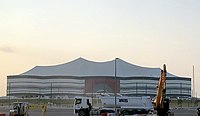
|

|
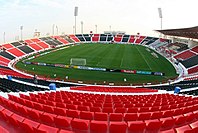
| |
| Host cities in Qatar |
Stadiums in Doha | ||
| Al Wakrah | Doha | ||
| Al Janoub Stadium | Ras Abu Aboud Stadium | Al Thumama Stadium | Khalifa International Stadium |
| Capacity: 40,000[115] | Capacity: 40,000[116] (under construction) |
Capacity: 40,000[117] (under construction) |
Capacity: 40,000[118] (upgraded) |

|

|
||
References[]
- ^ "2006 FIFA World Cup™: Strict criteria for stadium selection". FIFA. 25 June 2001.
- ^ Guide to the Bidding Process for the 2026 FIFA World Cup
- ^ Wilson, Bill (6 June 2006). "Stadiums renamed for Fifa sponsors". bbc.co.uk.
- ^ "World Cup Rewind: Largest attendance at a match in the 1950 Brazil final". Guinness World Records. 2018-06-12. Retrieved 2018-07-04.
Officially, 173,850 paid spectators crammed into Rio de Janeiro's Maracanã Stadium on July 16(...) Some estimates have even pegged the attendance as high as 199,000 or 210,000 unofficially
- ^ Goldblatt, David (2007). The Ball is Round: A Global History of Football. London: Penguin. p. 248. ISBN 978-0-14-101582-8.
- ^ Dunning, Eric; Malcolm, Dominic (2003). Sport. Routledge. p. 46. ISBN 978-0-415-26292-7.
- ^ Goldblatt (2008), p. 249
- ^ Glanville, p. 16
- ^ Murray 1998:69
- ^ Jump up to: a b c Norlin, p.23
- ^ Norlin, p.32
- ^ Jump up to: a b c Norlin, p.27
- ^ Norlin, p.30
- ^ Norlin, p.28
- ^ Ortega, Luis (2005), "De pasión de multitudes a rito privado", in Sagredo, Rafael; Gazmuri, Cristián (eds.), Historia de la vida privada en Chile (in Spanish), 3: El Chile contemporáneo. De 1925 a nuestros días (4th ed.), Santiago de Chile: Aguilar Chilena de Ediciones, ISBN 956-239-337-2
- ^ "Del 31 de mayo al 21 de junio de 1970" (in Spanish). La Nación. 30 June 1967.
- ^ "Building for the future". Christian Science Monitor. 19 October 1967.
- ^ "Altitude bugs soccer players". Meriden Journal. 2 June 1970.
- ^ "Problem of altitude". Ottawa Citizen. 2 June 1970.
- ^ "World Championship – Jules Rimet 1970 Cup Technical study" (PDF). FIFA.
- ^ Stadium capacities, Panini official album to World Cup 1982.
- ^ Alsos, Jan. "Planet World Cup – 1982 – Match Schedule". www.planetworldcup.com.
- ^ https://www.nytimes.com/1990/06/17/sports/world-cup-90-fan-violence-at-world-cup-finals.html
- ^ https://articles.latimes.com/1990-06-11/sports/sp-210_1_riot-police
- ^ Jump up to: a b c d e f g h i j k l "WM 1990 Sonderheft". Kicker (in German). May–June 1990. p. 185.
- ^ Jump up to: a b c d e f g h i j k l "World Cup '90: The Complete Collection". Orbis.
- ^ "WORLD CUP USA 1994 : The Best and the Worst". 14 July 1994 – via LA Times.
- ^ "Is Qatar too hot for the World Cup?".
- ^ "US 1994 was a World Cup of scorched feet and sweaty fans". 29 May 2014.
- ^ "The summer that changed U.S. soccer forever". 4 March 2014.
- ^ Jump up to: a b Dauncey & Hare, p. 98.
- ^ Jump up to: a b Dauncey & Hare, p. 99.
- ^ Dauncey & Hare, p. 107.
- ^ Dauncey & Hare, p. 101.
- ^ Dauncey & Hare, p. 104.
- ^ "2002 FIFA World Cup Korea/Japan – Report and Statistics" (PDF). FIFA. 2002. pp. 108–9. Retrieved 25 October 2013.
- ^ "Daegu World Cup Stadium". FIFA (Fédération Internationale de Football Association). Archived from the original on 3 August 2002. Retrieved 19 July 2014.
- ^ "Seoul World Cup Stadium". FIFA (Fédération Internationale de Football Association). Archived from the original on 10 August 2002. Retrieved 19 July 2014.
- ^ "Busan Asiad Main Stadium". FIFA (Fédération Internationale de Football Association). Archived from the original on 3 August 2002. Retrieved 19 July 2014.
- ^ "Incehon Munhak Stadium". FIFA (Fédération Internationale de Football Association). Archived from the original on 10 August 2002. Retrieved 19 July 2014.
- ^ "Ulsan Munsu Football Stadium". FIFA (Fédération Internationale de Football Association). Archived from the original on 10 June 2002. Retrieved 19 July 2014.
- ^ "Suwon World Cup Stadium". FIFA (Fédération Internationale de Football Association). Archived from the original on 10 August 2002. Retrieved 19 July 2014.
- ^ "Gwangju World Cup Stadium". FIFA (Fédération Internationale de Football Association). Archived from the original on 10 August 2002. Retrieved 19 July 2014.
- ^ "Jeonju World Cup Stadium". FIFA (Fédération Internationale de Football Association). Archived from the original on 10 August 2002. Retrieved 19 July 2014.
- ^ "Jeju World Cup Stadium". FIFA (Fédération Internationale de Football Association). Archived from the original on 10 August 2002. Retrieved 19 July 2014.
- ^ "Daejeon World Cup Stadium". FIFA (Fédération Internationale de Football Association). Archived from the original on 12 December 2002. Retrieved 19 July 2014.
- ^ "International Stadium Yokohama". FIFA (Fédération Internationale de Football Association). Archived from the original on 10 August 2002. Retrieved 19 July 2014.
- ^ "Saitama Stadium 2002". FIFA (Fédération Internationale de Football Association). Archived from the original on 4 June 2002. Retrieved 19 July 2014.
- ^ "Shizuoka Stadium Ecopa". FIFA (Fédération Internationale de Football Association). Archived from the original on 10 August 2002. Retrieved 19 July 2014.
- ^ "Nagai Stadium". FIFA (Fédération Internationale de Football Association). Archived from the original on 10 August 2002. Retrieved 19 July 2014.
- ^ "Miyagi Stadium". FIFA (Fédération Internationale de Football Association). Archived from the original on 10 August 2002. Retrieved 19 July 2014.
- ^ "Oita Stadium Big Eye". FIFA (Fédération Internationale de Football Association). Archived from the original on 10 June 2002. Retrieved 19 July 2014.
- ^ "Niigata Stadium Big Swan". FIFA (Fédération Internationale de Football Association). Archived from the original on 10 August 2002. Retrieved 19 July 2014.
- ^ "Ibaraki Kashima Stadium". FIFA (Fédération Internationale de Football Association). Archived from the original on 10 August 2002. Retrieved 19 July 2014.
- ^ "Kobe Wing Stadium". FIFA (Fédération Internationale de Football Association). Archived from the original on 9 April 2002. Retrieved 19 July 2014.
- ^ "Sapporo Dome". FIFA (Fédération Internationale de Football Association). Archived from the original on 2 August 2002. Retrieved 19 July 2014.
- ^ Jump up to: a b "Stadiums renamed for Fifa sponsors". BBC. 6 June 2006. Retrieved 29 March 2008.
- ^ "Berlin". FIFA (Fédération Internationale de Football Association). Archived from the original on 16 June 2006. Retrieved 16 July 2014.
- ^ "Dortmund". FIFA (Fédération Internationale de Football Association). Archived from the original on 16 June 2006. Retrieved 16 July 2014.
- ^ "Munich". FIFA (Fédération Internationale de Football Association). Archived from the original on 16 June 2006. Retrieved 16 July 2014.
- ^ "Stuttgart". FIFA (Fédération Internationale de Football Association). Archived from the original on 16 June 2006. Retrieved 16 July 2014.
- ^ "Gelsenkirchen". FIFA (Fédération Internationale de Football Association). Archived from the original on 16 June 2006. Retrieved 16 July 2014.
- ^ "Hamburg". FIFA (Fédération Internationale de Football Association). Archived from the original on 16 June 2006. Retrieved 16 July 2014.
- ^ "Frankfurt". FIFA (Fédération Internationale de Football Association). Archived from the original on 16 June 2006. Retrieved 16 July 2014.
- ^ "Cologne". FIFA (Fédération Internationale de Football Association). Archived from the original on 16 June 2006. Retrieved 16 July 2014.
- ^ "Hanover". FIFA (Fédération Internationale de Football Association). Archived from the original on 16 June 2006. Retrieved 16 July 2014.
- ^ "Leipzig". FIFA (Fédération Internationale de Football Association). Archived from the original on 16 June 2006. Retrieved 16 July 2014.
- ^ "Kaiserslautern". FIFA (Fédération Internationale de Football Association). Archived from the original on 16 June 2006. Retrieved 16 July 2014.
- ^ "Nuremberg". FIFA (Fédération Internationale de Football Association). Archived from the original on 16 June 2006. Retrieved 16 July 2014.
- ^ "2010 Soccer World Cup Fan Parks & 2010 Host Cities". Google Earth Community. 29 October 2007. Retrieved 1 December 2011.
- ^ "Altitude will have impact on World Cup ball". NBC News. 4 December 2009. Retrieved 13 June 2010.
- ^ "Altitude training and physical performance for high altitude football". Altitude.org. Archived from the original on 15 July 2010. Retrieved 29 June 2010.
- ^ Jackson, Jamie (7 June 2010). "World Cup 2010: England's altitude training will be tested against USA". The Guardian. London. Archived from the original on 10 June 2010. Retrieved 13 June 2010.
- ^ Edwards, Piers (23 February 2010). "Fifa medical chief downplays World Cup altitude effect". BBC Sport. Retrieved 13 June 2010.
- ^ "Quick guide to the ten World Cup grounds". Racing Post. Archived from the original on 13 May 2011. Retrieved 13 June 2010.
- ^ "And the city to avoid..." Soccer America. 3 September 2009. Archived from the original on 1 June 2010. Retrieved 13 June 2010.
- ^ "Soccer City Stadium – Johannesburg". FIFA. Retrieved 1 December 2011.
- ^ "Host cities in 1950 FIFA World Cup". Colunas.globoesporte.com. Retrieved 9 October 2011.
- ^ "2014 FIFA World Cup: Luck of the draw 'an essential component'". BBC Sport. 2 December 2013.
- ^ "Team Base Camps for Brazil 2014 announced". FIFA. 21 January 2014.
- ^ "FIFA Fan Fest locations confirmed". FIFA. 20 January 2014.
- ^ Jump up to: a b c d e f g h i j k l m 2014 FIFA World Cup Brazil Venues. FIFA. 18 January 2012. Retrieved 12 June 2014.
- ^ "World Cup 2018 stadiums: A guide to the venues of this summer's tournament". The Telegraph. 30 May 2018. Retrieved 14 June 2018.
- ^ "Стадион на 45000 зрительских мест к Чемпионату мира по футболу в Нижнем Новгороде" [Stadium for 45,000 spectators for the World Cup in Nizhny Novgorod]. stroytransgaz.ru (in Russian). Archived from the original on 30 September 2017. Retrieved 31 May 2018.
- ^ "Стадион на Крестовском ввели в эксплуатацию". fontanka.ru (in Russian). 29 December 2016. Archived from the original on 20 February 2017. Retrieved 31 May 2018.
- ^ "Стадион ЧМ-2018 по футболу в Волгограде введен в эксплуатацию" [The 2018 World Cup in Volgograd was put into operation] (in Russian). RIA Novosti. 3 April 2018. Archived from the original on 3 April 2018. Retrieved 31 May 2018.
- ^ "Luzhniki Stadium". FIFA. Retrieved 15 June 2018.
- ^ "Spartak Stadium". FIFA. Retrieved 15 June 2018.
- ^ "Saint Petersburg Stadium". FIFA. Retrieved 15 June 2018.
- ^ "Fisht Stadium". FIFA. Retrieved 15 June 2018.
- ^ "Samara Arena". FIFA. Retrieved 15 June 2018.
- ^ "Kazan Arena". FIFA. Retrieved 15 June 2018.
- ^ "Rostov Arena". FIFA. Retrieved 15 June 2018.
- ^ "Volgograd Arena". FIFA. Retrieved 15 June 2018.
- ^ "Nizhny Novgorod Stadium". FIFA. Retrieved 15 June 2018.
- ^ "Ekaterinburg Arena". FIFA. Retrieved 15 June 2018.
- ^ "Mordovia Arena". FIFA. Retrieved 15 June 2018.
- ^ "Kaliningrad Stadium". FIFA. Retrieved 15 June 2018.
- ^ "Bidding Nation Qatar 2022 – Stadiums". Qatar2022bid.com. Archived from the original on 3 May 2010. Retrieved 30 May 2010.
- ^ "Stadiums". Supreme Committee for Delivery & Legacy. Retrieved 27 March 2019.
- ^ "Football and Sustainability in the Desert, Qatar 2022 Green World Cup's Stadiums: Legal Perspective". European Journal of Social Sciences: 475–493. SSRN 3096185.
- ^ "2022 FIFA World Cup Bid Evaluation Report: Qatar" (PDF). FIFA. 5 December 2010.
- ^ Conway, Richard (30 October 2014). "World Cup 2022: European clubs want spring finals in Qatar". BBC Sport. Retrieved 1 November 2014.
- ^ "Report: Qatar neighbors could host 2022 WC games". Fox Soccer/AP. 9 December 2010. Archived from the original on 26 April 2011.
- ^ "FIFA 'backs' winter 2022 Qatar cup – FOOTBALL". Al Jazeera. Archived from the original on 13 May 2011. Retrieved 28 February 2012.
- ^ "Jordan's Prince Ali calls for winter WCup in Qatar". Yahoo! Sports/AP. 13 December 2010.
- ^ "Qatar 2022: Nine stadiums instead of twelve? –". Stadiumdb.com. 25 April 2013. Retrieved 25 May 2013.
- ^ Fattah, Zainab (22 April 2013). "Qatar Is in Talks to Reduce World Cup Stadiums, BofA Says". Bloomberg. Retrieved 25 May 2013.
- ^ "Official: Qatar has cut its 2022 World Cup budget almost in half". Doha News. 7 April 2017. Archived from the original on 24 December 2019. Retrieved 16 April 2017.
- ^ "Stadiums". Supreme Committee for Delivery & Legacy. 6 July 2018.
- ^ "Infantino: Qatar neighbours could help host World Cup". ESPN. 2 January 2019. Retrieved 2 January 2019.
- ^ "Al Bayt Stadium: A uniquely Qatari stadium, to rival the best in the world". 8 January 2018.
- ^ "Ras Abu Aboud Stadium: A legacy for the community". 8 January 2018.
- ^ "Al Rayyan Stadium: The gateway to the desert opens its doors to the world". 8 January 2018.
- ^ "Tradition and innovation come together as striking Al Janoub Stadium in Al Wakrah City is opened". 16 May 2019.
- ^ "Qatar Foundation Stadium: An amazing experience for fans & a bright future for football". 8 January 2018. Archived from the original on 8 January 2018. Retrieved 8 January 2018.
- ^ "Al Thuymama Stadium: A tribute to our region". 8 January 2018.
- ^ "Khalifa International Stadium: Qatar's most historic stadium & a crucial player for 2022". 8 January 2018.
External links[]
- FIFA World Cup stadiums


